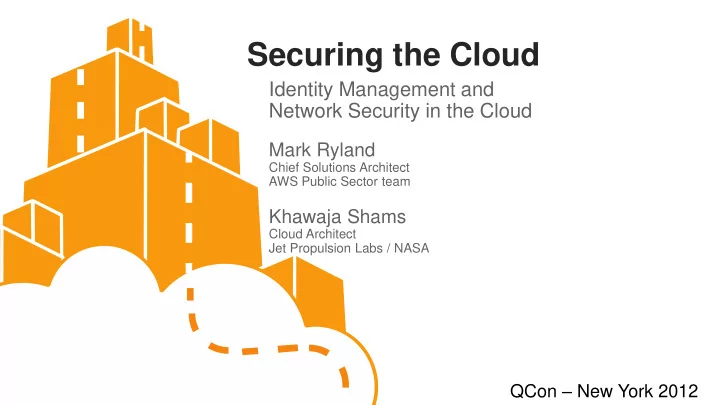

Securing the Cloud Identity Management and Network Security in the Cloud Mark Ryland Chief Solutions Architect AWS Public Sector team Khawaja Shams Cloud Architect Jet Propulsion Labs / NASA QCon – New York 2012
Agenda Identity & Access Management • Core concepts: user, groups, roles, policies • Demos: multi-factor authentication; S3 access control policies; introducing roles for Instances EC2 networking • EC2 classic networking • Introducing Virtual Private Cloud • Demos: network control via security groups; public and private connectivity to VPC; forensics in the cloud QCon – New York 2012
Identity & Access Management Identities & access control for AWS management plane • AWS APIs and console • Not for operating system or application level • Partners like Xceedium provide integrations across levels Principals: users, groups, and roles Actions: service-specific verbs Resources: very rich set of AWS objects • Addressable via Amazon Resource Names (ARNs) Single policy language applies everywhere QCon – New York 2012
Example Policy { "Statement": [ { "Effect": "Allow", "Action": "s3:ListAllMyBuckets", "Resource": "arn:aws:s3 :::*“, "Condition": {} //e.g., time, transport, source ARN, source IP, UserAgent, Referrer }, { "Effect": "Allow", "Action": [ "s3:GetBucketLocation", "s3:ListBucket", "s3:GetObject", "s3:PutObject" ], "Resource": "arn:aws:s3:::qcon-nyc", "Resource": "arn:aws:s3:::qcon-nyc/*" } ] QCon – New York 2012 }
Model: Principals and Resources Single policy language used to express permissions on both principals and resources (actions on either/both) Some services support only actions/verbs; others provide resource-level permissioning • More resource-level will be added over time Policies are AND’d together; first “deny” ends processing QCon – New York 2012
Model For summary of service- level support, see http://docs.amazonwebservices.com/I AM/latest/UserGuide/Using_SpecificP roducts.html
IAM Demos Create user, assign to group Add virtual MFA for interactive sessions (and some APIs) Create S3-related policy Login as new user, try S3 operations Start instance in role, view identity metadata QCon – New York 2012
Roles for Instances Example of using new STS model of auth in a REST call: https://sdb.amazonaws.com/ ?Action=GetAttributes &AWSAccessKeyId= Access Key ID provided by AWS Security Token Service &DomainName=MyDomain &ItemName=MyItem &SignatureVersion=2 &SignatureMethod=HmacSHA256 &Timestamp=2010-01-25T15%3A03%3A07-07%3A00 &Version=2009-04-15 &Signature= Signature calculated using the SecretKeyId provided by AWS STS &SecurityToken= Security Token Value AWS SDKs to the work for you QCon – New York 2012
Agenda Identity & Access Management • Core concepts: user, groups, roles, policies • Multi-factor authentication • Roles for Instances EC2 networking • EC2 classic networking • The power of security groups • Additional capabilities of Virtual Private Cloud QCon – New York 2012
EC2 Standard Networking Distinct private/internal and public/external IPs • True 1:1 NAT (no port translation) • “Split - brained” DNS • Addresses change upon reboot Security groups control ingress Elastic IPs: fixed public IPs QCon – New York 2012
Internet EC2 instances dynamically assigned private IP addresses from the one large internal Amazon IP address range 10.134.2.3 10.218.5.17 10.1.2.3 10.27.45.16 10.243.3.5 10.8.55.5 10.141.9.8 10.99.42.97 10.155.6.7 10.131.7.28 10.16.22.33 10.6.78.201 Availability Zone 1a Availability Zone 1b Customer 1 Customer 2 Customer 3
23.20.103.11 23.19.11.5 72.43.22.45 23.20.146.1 23.20.151.66 72.43.2.77 72.43.22.5 Internet 72.44.32.9 23.20.148.59 23.19.10.51 72.44.21.7 72.43.1.7 EC2 instances dynamically assigned public IP addresses on border network from Amazon’s public IP address blocks 10.134.2.3 10.218.5.17 10.1.2.3 10.27.45.16 10.243.3.5 10.8.55.5 10.141.9.8 10.99.42.97 10.155.6.7 10.131.7.28 10.16.22.33 10.6.78.201 Availability Zone 1a Availability Zone 1b Customer 1 Customer 2 Customer 3
Introducing AWS Virtual Private Cloud User-defined virtual IP networking for EC2 Private or mixed private/public addressing and ingress/egress Re-use of proven and well-understood networking concepts and technologies QCon – New York 2012
VPC Capabilities in a Nutshell User-defined address space up to /16 • Completely disjoint from all other tenant networks Up to 20* user-defined subnets up to /16 User-defined: • Virtual routing, DHCP servers, and NAT instances • Internet gateways, private, customer gateways, and VPN tunnels Private IPs are stable once assigned Internet access is not automatic Elastic Network Interfaces (virtual NICs) QCon – New York 2012
Enhanced Security Capabilities Network topology, routing, and subnet ACLs Security group enhancements • Egress control; dynamic (re)assignment; multiple SGs; richer protocol support Multiple network interfaces per instance Completely private networking via VPN Support for dedicated instances QCon – New York 2012
Common Use Cases Mixing public and private resources • E.g. , web-facing hosts with DMZ subnets, control plane subnets Workloads that expect fixed IPs and/or multiple NICs AWS cloud as private extension of on-premises network • Accessible from on-premises hosts • No change to addressing • No change to Internet threat/risk posture QCon – New York 2012
Internet www.aws-wwps.com webserver2 webserver3.aws-wwps.com 107.21.19.137 107.21.19.141 webserver1.aws-wwps.com Internet Gateway (IGW + EIPs = direct Internet access) 107.21.19.136 VPC Subnets VPC Subnets VPC Subnets Webserver1 Webserver3 Webserver2 10.1.100.101/24 10.1.102.101/24 10.1.101.101/24 AD/DNS server AD/DNS server 10.1.0.20/24 10.1.1.20/24 Availability Zone 1a Availability Zone 1b Availability Zone 1b Virtual Private Gateway VPN Connection Customer Gateway VPC Customer Customer Data Center
Rich Capabilities in VPC ELB, AutoScaling, CloudWatch, alarms Relational Database Service (MySQL engine, for now) Elastic MapReduce CloudFormation And many others, with more to come… “ Blackbox ” services with public endpoints reachable via Internet gateway (or VPN) QCon – New York 2012
Networking Demos Ping instances from inside and outside VPC Change security group content and examine behavior • Ping • Egress control (web browser) Drop public IPs, switch to accessing VPC from (virtual) “on premises” network QCon – New York 2012
Simulation of “on - premises” VPC access via Sophos Security Gateway (ASG) EC2 virtual appliance and Sophos Remote Ethernet (RED) device VPC Subnets VPC Subnets 10.1.101.101 10.1.100.101 10.1.0.20 10.1.1.20 Availability Zone 1a Availability Zone 1b Virtual Private Gateway VPN Connection Customer Gateway SSG running in EC2 RED Try it! SSID: aws_qcon New York Marriott
Securing the Cloud Questions & Answers QCon – New York 2012
Recommend
More recommend